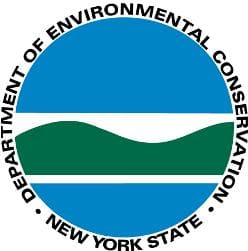Deepwater Ciscoes to be Re-introduced into New York’s Lake Ontario
OutdoorHub 11.08.12

The “bloater” fish, a deepwater cisco, was re-introduced into Lake Ontario offshore of Oswego, bringing the fish back to the lake for the first time in nearly thirty years, the New York State Department of Environmental Conservation (DEC) and partner agencies announced today. This historic action is the first of its kind in the Great Lakes and is the culmination of several years of collaborative laboratory, hatchery and field research conducted by federal, state, and provincial agencies. The last known fish was collected in 1983.
“Lake Ontario’s sport fisheries are a significant economic driver in New York State, and were valued at more than $113 million in 2007,” said DEC Commissioner Joe Martens. “Re-establishing bloaters in Lake Ontario will diversify the fish community, adding stability to the lake’s ecosystem and sport fisheries.”
Re-establishing self-sustaining populations of bloater in Lake Ontario is the focus of a cooperative, international effort between DEC, the Ontario Ministry of Natural Resources (OMNR), the U.S. Fish and Wildlife Service (USFWS), the U.S. Geological Survey (USGS) and the Great Lakes Fishery Commission to restore native fish populations in Lake Ontario. This program will improve food web stability and mitigate negative impacts of invasive species; however, it will require a long-term stocking program.
Today’s event, at the Lake Ontario Event and Conference Center, also highlighted the new USGS Research Vessel (R/V) Kaho, which is stationed at the USGS Lake Ontario Biological Station in Oswego. The new vessel will be used to transport the bloaters offshore for stocking over deep water.
Russ Strach, Director of the USGS Great Lakes Science Center, said, “The capital investment in the new research vessel demonstrates USGS’ commitment to cutting-edge deepwater science in Lake Ontario. The new vessel greatly enhances our ability to conduct ecosystem-based fishery research to address management questions important to our partner agencies. I’m proud to see the platform used by the partnership working to restore this important native species.”
Deepwater ciscoes, a diverse group of species including bloater, kiyi, blackfin cisco, and shortnose cisco, were once the most abundant prey fish in the lake and supported important commercial fisheries. Members of the whitefish family, bloaters feed primarily on invertebrates in water depths from 180 feet to 650 feet, spawning in winter at great depth, and were an important food source for native lake trout and burbot.
By the mid-20th century, populations declined dramatically in association with over-harvest and expanding populations of invasive alewife and rainbow smelt. Re-introducing bloaters will provide more food choices for predators, such as lake trout and salmon, and diversify the Lake Ontario fish community. Lake trout and salmon that feed primarily on alewife can experience reproductive failure due to a vitamin B deficiency. Predators that feed on native species like bloater are less likely to experience reproductive failure.
The juvenile bloaters stocked today originated from eggs collected by USFWS staff on Lake Michigan during January and February, 2012. Bloater eggs were hatched and juveniles reared at the USGS Tunison Laboratory of Aquatic Sciences and the OMNR’s White Lake Fish Culture Station.
USFWS Midwest Assistant Regional Director for Fisheries Todd Turner said, “Restoring native prey fish to Lake Ontario and all the Great Lakes is a priority for the Service. The Midwest Region’s Fisheries Program is pleased that the bloater eggs we collected and fertilized from Lake Michigan will contribute to this historic reintroduction event for the Great Lakes.”
Jaime Geiger, Northeast Assistant Regional Director for Fisheries said, “We support the efforts of this great partnership and look forward to promoting long term success for the fishery of Lake Ontario.”
Michael Morencie, Director of the Fish and Wildlife Services Branch of the Ontario Ministry of Natural Resources, said, “Ontario has a strong commitment to restoring native species in Lake Ontario. This stocking event is an important step in achieving our shared goal to restore native species diversity in the lake.”
“Lake Ontario’s food web has been devastated by repeated invasive species introductions,” said Dr. Chris Goddard, Executive Secretary of the Great Lakes Fishery Commission. “Re-establishing deepwater ciscoes in the lake will reduce opportunities for new invasive species to colonize the offshore, deepwater zone and fill the niche that bloaters are most suited to fill.”

